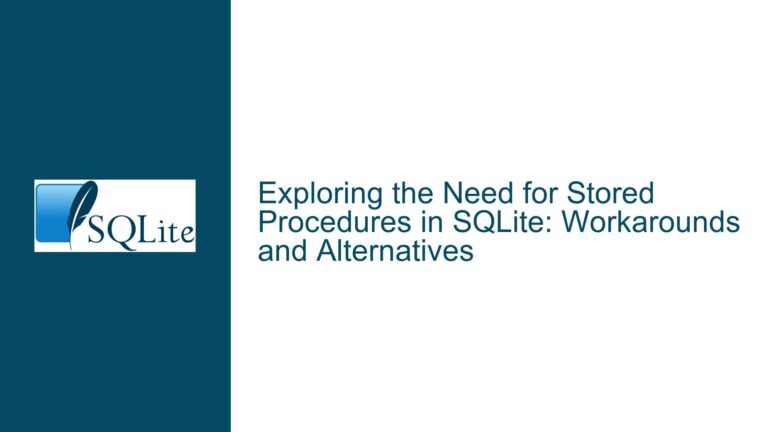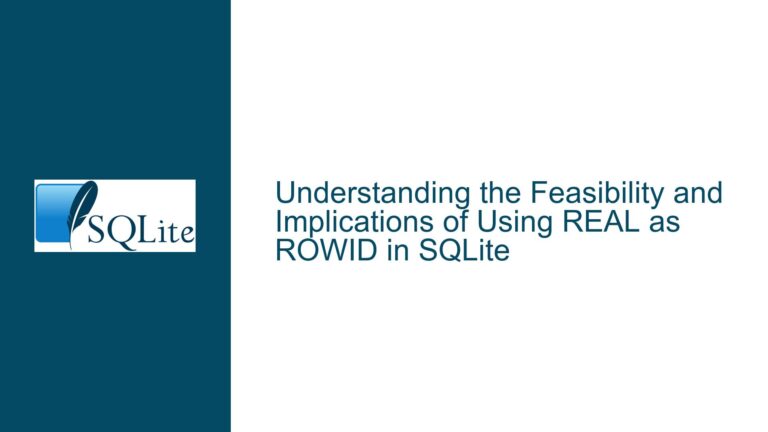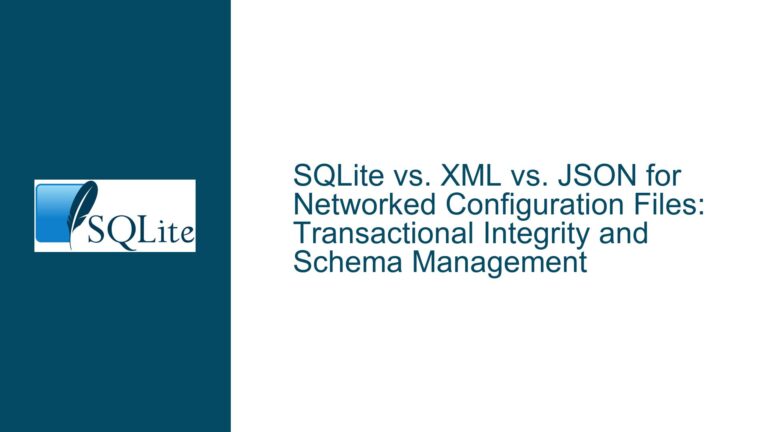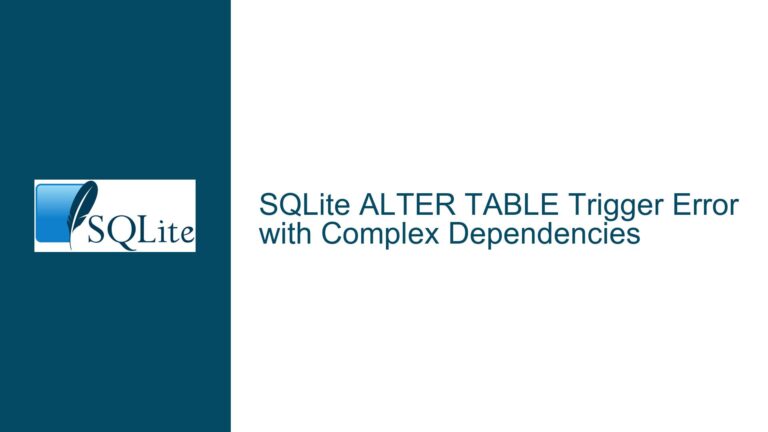Retrieving SQLite Column Affinity in C#: Schema Queries and Affinity Determination
Understanding SQLite’s Dynamic Typing and Affinity Mismatches
SQLite’s type affinity system is a foundational concept that dictates how values are stored and coerced in columns. Unlike traditional databases where column types rigidly enforce data formats, SQLite uses a flexible "affinity" system based on declared column types. This design allows compatibility with diverse schemas but introduces challenges when programmatically determining column storage class affinity, especially in C# with the System.Data.SQLite library. The core issue revolves around discrepancies between declared column types (e.g., MEMO, BIT, fronk), their inferred affinities (e.g., NUMERIC instead of TEXT), and the data returned by schema queries. Developers often assume that standard schema introspection methods (e.g., GetSchema("Columns")) directly report affinity, but they instead reflect SQLite’s internal mappings or Entity Framework (EDM) abstractions.
Decoding Column Affinity Determination Rules
SQLite assigns affinity based on the declared type of a column using five hierarchical rules (documented in Determination of Column Affinity):
- TEXT affinity: If the declared type contains
CHAR,CLOB, orTEXT. - INTEGER affinity: If the declared type contains
INT. - REAL affinity: If the declared type contains
REAL,FLOA, orDOUB. - BLOB affinity: If the declared type includes
BLOBor is unspecified. - NUMERIC affinity: For all other cases.
These rules explain why non-standard types like MEMO (no matching keywords) default to NUMERIC affinity, while BIT (no INT substring) also falls into NUMERIC. The fronk column, being unrecognized, similarly defaults to NUMERIC. The confusion arises when developers expect these types to map to affinities based on intuition (e.g., MEMO as TEXT) or other database systems’ conventions. Additionally, schema introspection tools like PRAGMA table_info or GetSchema("Columns") return the declared type (as defined in CREATE TABLE), not the affinity, requiring manual affinity derivation.
Resolving Affinity Mismatches and Extracting Affinity Programmatically
Step 1: Retrieve Declared Column Types
The first step is to obtain the declared type of each column. While PRAGMA table_info("MyTable") returns the raw declared type (e.g., BIT, fronk), the GetSchema("Columns") method in System.Data.SQLite provides a DATA_TYPE field that maps declared types to .NET types (e.g., bit, memo). However, this mapping is not equivalent to SQLite’s affinity. To get the declared type accurately:
using (var command = connection.CreateCommand())
{
command.CommandText = "SELECT name, type FROM pragma_table_info('MyTable')";
using (var reader = command.ExecuteReader())
{
while (reader.Read())
{
string columnName = reader.GetString(0);
string declaredType = reader.GetString(1);
// Process declaredType to determine affinity
}
}
}
Step 2: Apply Affinity Determination Rules in Code
Implement a function to convert declared types to affinities. For example:
public static string GetAffinity(string declaredType)
{
if (string.IsNullOrEmpty(declaredType))
return "BLOB";
string typeUpper = declaredType.ToUpperInvariant();
if (typeUpper.Contains("INT"))
return "INTEGER";
if (typeUpper.Contains("CHAR") || typeUpper.Contains("CLOB") || typeUpper.Contains("TEXT"))
return "TEXT";
if (typeUpper.Contains("BLOB"))
return "BLOB";
if (typeUpper.Contains("REAL") || typeUpper.Contains("FLOA") || typeUpper.Contains("DOUB"))
return "REAL";
return "NUMERIC";
}
This handles edge cases like BIT → NUMERIC and MEMO → NUMERIC.
Step 3: Leverage Strict Tables for Type Enforcement (Optional)
SQLite 3.37.0+ introduced strict tables, which enforce column types at insertion. While this doesn’t directly solve affinity determination, it ensures columns reject mismatched types, making declared types more predictable:
CREATE TABLE MyTable (txt_Text TEXT STRICT, num_Int INTEGER STRICT);
Step 4: Use Low-Level APIs for Declared Type Extraction
For advanced scenarios, use sqlite3_column_decltype() via P/Invoke or a wrapper library to access the declared type during query preparation. This bypasses schema metadata abstractions:
// Example using Microsoft.Data.Sqlite (different library but similar approach)
using (var cmd = connection.CreateCommand())
{
cmd.CommandText = "SELECT * FROM MyTable";
using (var reader = cmd.ExecuteReader())
{
var schemaTable = reader.GetSchemaTable();
foreach (DataRow row in schemaTable.Rows)
{
string columnName = row["ColumnName"].ToString();
string dataTypeName = row["DataTypeName"].ToString();
// Map dataTypeName to affinity
}
}
}
Step 5: Validate with Storage Class Inspection
Use typeof() in queries to audit storage classes per row. While not a direct solution, this helps diagnose mismatches between declared affinity and actual stored data:
command.CommandText = "SELECT typeof(random) FROM MyTable";
// Iterate results to see storage classes (e.g., 'text', 'integer', 'real')
Conclusion
SQLite’s type affinity system requires developers to derive affinities from declared types using explicit rules rather than relying on schema metadata or ORM abstractions. By querying declared types via PRAGMA table_info and applying affinity determination logic in C#, developers can accurately map columns to their storage class affinities. For stricter type enforcement, migrating to strict tables ensures declared types align with stored data, reducing ambiguity. This approach bridges the gap between SQLite’s dynamic typing and the need for reliable type metadata in applications.






